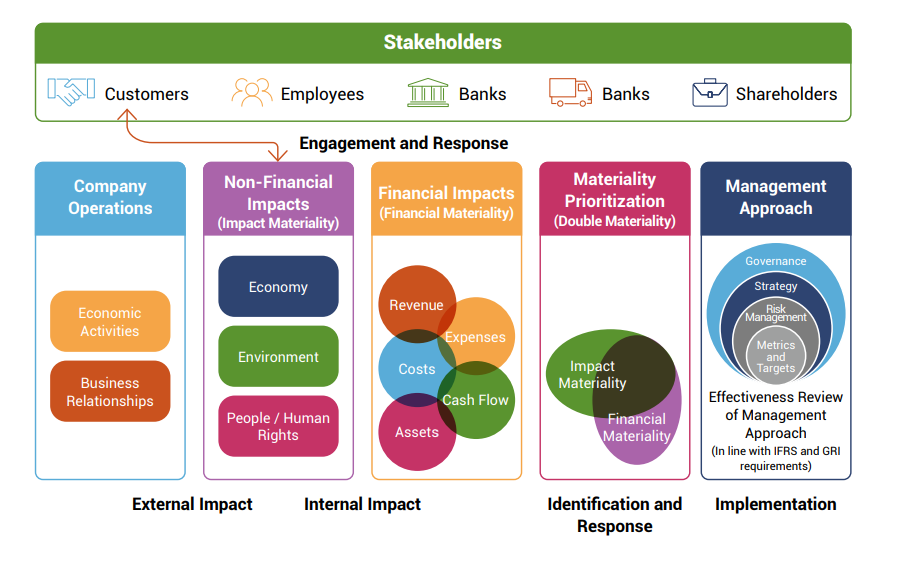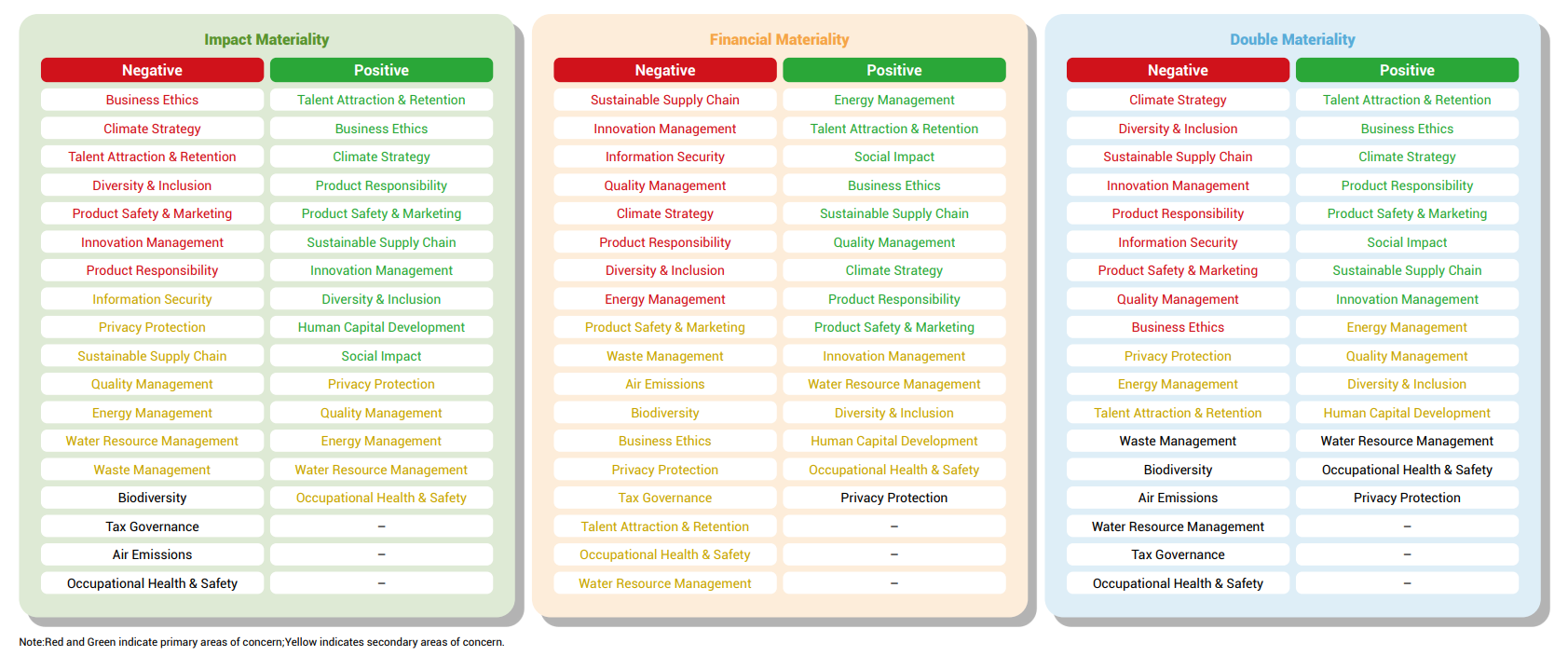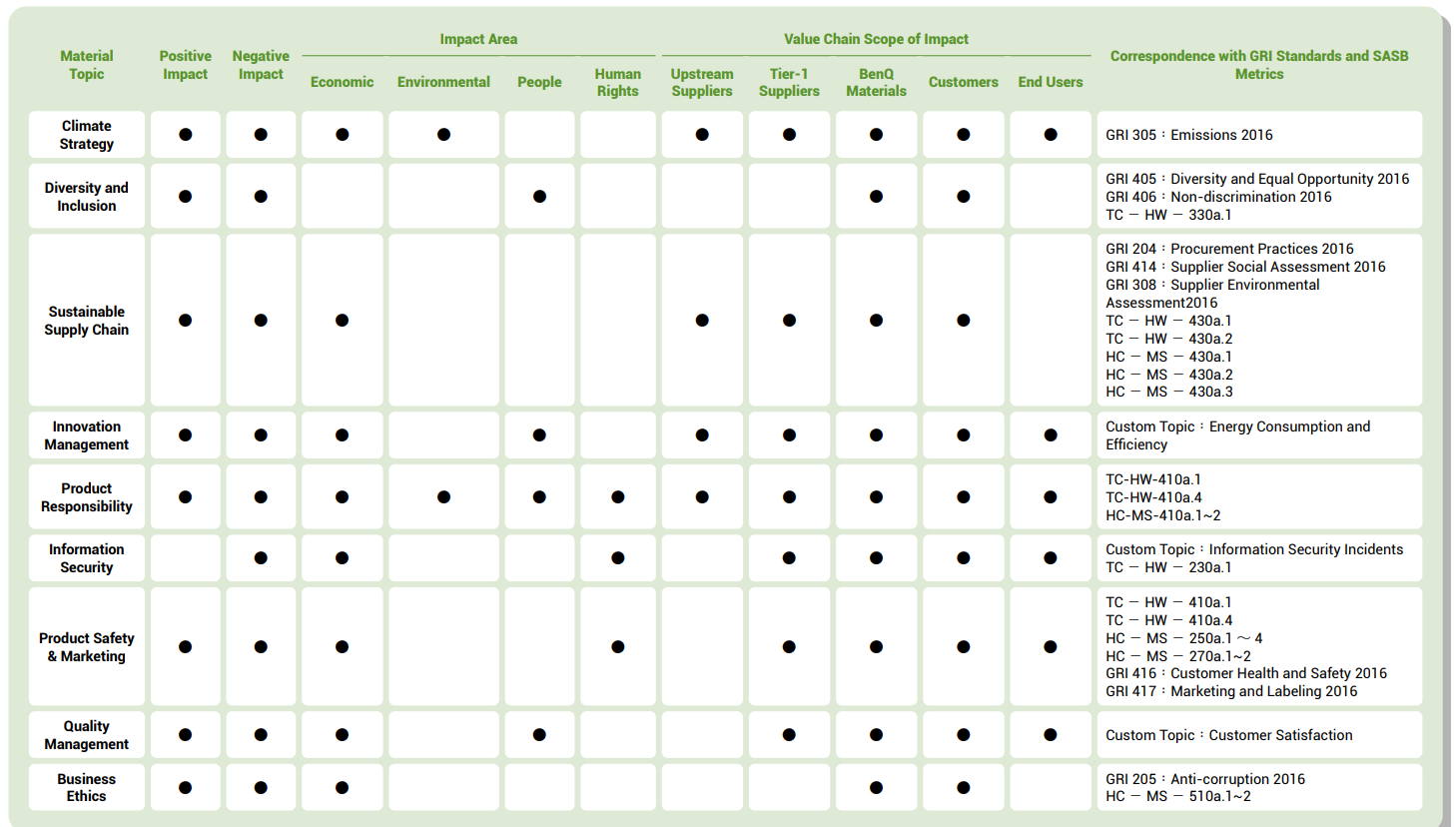Materiality Identification and Analysis
BenQ Materials conducts a sustainability impact assessment every two years to review and identify high-impact issues that serve as the basis for formulating its sustainability strategies and action plans. For each key issue, the company sets short-, medium-, and long-term goals to guide continuous improvement. In light of the formal release of the IFRS Sustainability Disclosure Standards and the European Sustainability Reporting Standards (ESRS) in 2023, BenQ Materials adopted the GRI 3: Material Topics 2021 as its foundational framework. At the same time, it integrated the principles and guidance from IFRS and ESRS regarding sustainability impacts to implement the Double Materiality approach. This approach incorporates:
• Impact Materiality: The company's impacts on the economy, environment, people, and human rights (external impacts)
• Financial Materiality: How those external impacts create or change financial risks and opportunities for the company (internal impacts). BenQ Materials applies a five-stage materiality identification process, evaluating the company's operational impacts across various sustainability dimensions. The results are synthesized to prioritize material topics for disclosure, based on a balanced analysis of both external and internal impacts.


Based on the results of the double materiality impact analysis, BenQ Materials identified a total of 9 negatively material topics and 8 positively material topics. In addition, 3 negative and 4 positive topics were classified as secondary material topics, to be continuously monitored.
Following a comprehensive review and evaluation by the ESG Sustainability Committee, the following 9 topics with significant negative impacts were prioritized for disclosure in this report. These are the topics for which management approaches and implementation outcomes are discussed in detail:
• Climate Strategy • Diversity and Inclusion • Sustainable Supply Chain • Innovation Management • Product Responsibility • Information Security • Product Safety and Marketing • Quality Management • Business Ethics
This year marks the first adoption of the double materiality assessment methodology. In light of increasing global focus on human rights, diversity and inclusion has emerged as a critical factor in responsible business practices. Furthermore, the growing frequency of extreme weather events poses direct and indirect risks to the hardware and medical device industries, increasing the relevance of product responsibility and product safety and marketing. Lastly, business ethics remains a foundational principle of corporate operations.
As a result, compared to the previous reporting year, four new topics have been added to the list of material topics for priority disclosure: • Diversity and Inclusion • Product Responsibility • Product Safety and Marketing • Business Ethics
A review was conducted of all 31 GRI Topic Standards, and those relevant to BenQ Materials' identified material topics were mapped accordingly. As a result, 6 applicable GRI Topic Standards and 3 organization-specific (custom) topics were selected. In addition, relevant disclosure topics from the SASB Standards for the Hardware and Medical Equipment & Supplies industries were also referenced to align with industry-specific expectations. This mapping formed the foundation for initiating the preparation of this sustainability report.

• Impact Materiality: The company's impacts on the economy, environment, people, and human rights (external impacts)
• Financial Materiality: How those external impacts create or change financial risks and opportunities for the company (internal impacts). BenQ Materials applies a five-stage materiality identification process, evaluating the company's operational impacts across various sustainability dimensions. The results are synthesized to prioritize material topics for disclosure, based on a balanced analysis of both external and internal impacts.

Materiality Identification and Analysis

Material Topics Identified and Disclosed
Based on the results of the double materiality impact analysis, BenQ Materials identified a total of 9 negatively material topics and 8 positively material topics. In addition, 3 negative and 4 positive topics were classified as secondary material topics, to be continuously monitored.
Following a comprehensive review and evaluation by the ESG Sustainability Committee, the following 9 topics with significant negative impacts were prioritized for disclosure in this report. These are the topics for which management approaches and implementation outcomes are discussed in detail:
• Climate Strategy • Diversity and Inclusion • Sustainable Supply Chain • Innovation Management • Product Responsibility • Information Security • Product Safety and Marketing • Quality Management • Business Ethics
This year marks the first adoption of the double materiality assessment methodology. In light of increasing global focus on human rights, diversity and inclusion has emerged as a critical factor in responsible business practices. Furthermore, the growing frequency of extreme weather events poses direct and indirect risks to the hardware and medical device industries, increasing the relevance of product responsibility and product safety and marketing. Lastly, business ethics remains a foundational principle of corporate operations.
As a result, compared to the previous reporting year, four new topics have been added to the list of material topics for priority disclosure: • Diversity and Inclusion • Product Responsibility • Product Safety and Marketing • Business Ethics

Mapping of Material Sustainability Topics to Reporting Standards
A review was conducted of all 31 GRI Topic Standards, and those relevant to BenQ Materials' identified material topics were mapped accordingly. As a result, 6 applicable GRI Topic Standards and 3 organization-specific (custom) topics were selected. In addition, relevant disclosure topics from the SASB Standards for the Hardware and Medical Equipment & Supplies industries were also referenced to align with industry-specific expectations. This mapping formed the foundation for initiating the preparation of this sustainability report.










